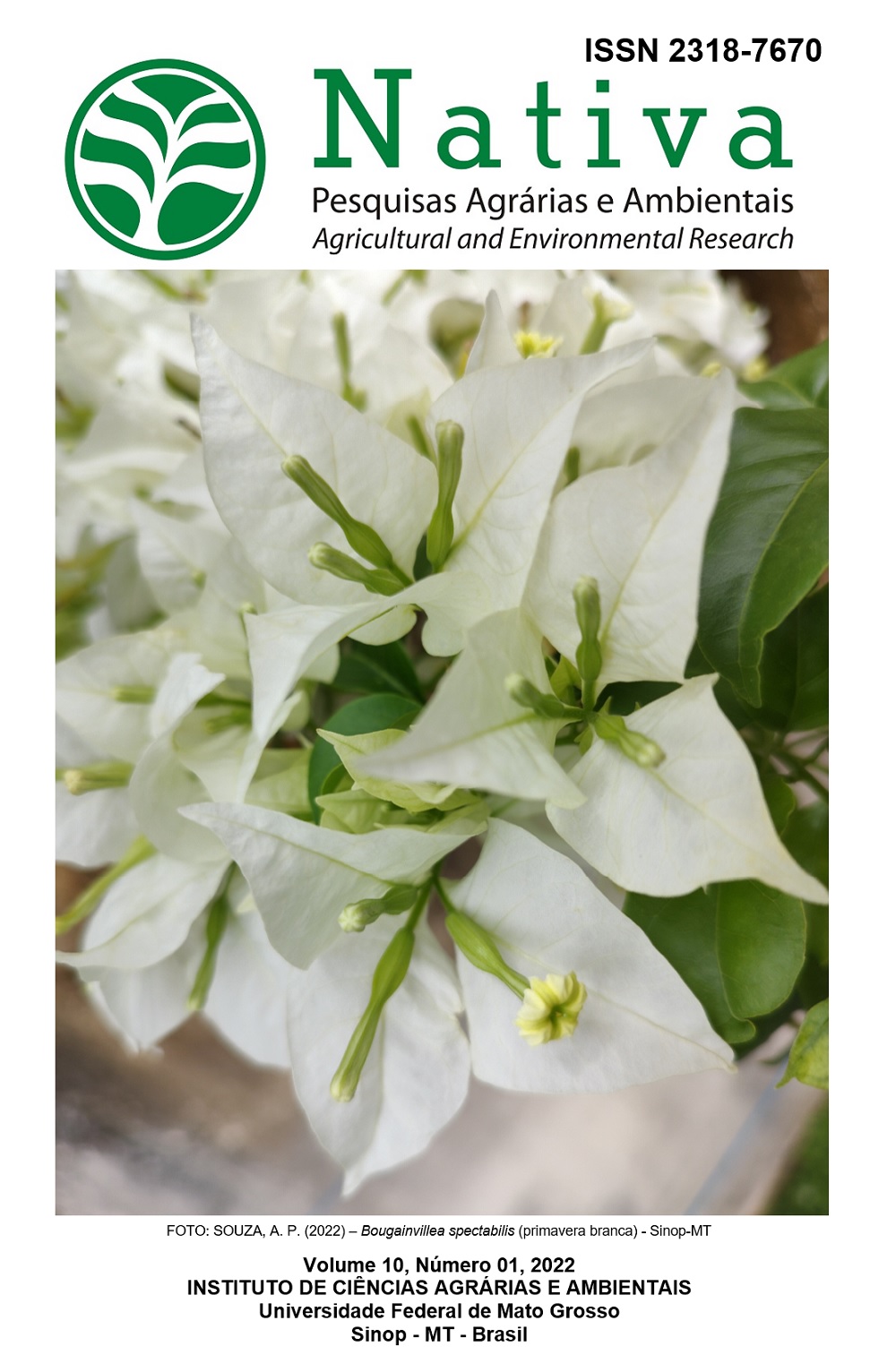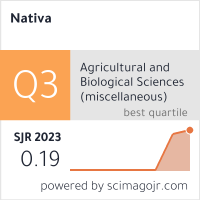SEEDLING PRODUCTION OF Mimosa calodendron Mart. ex Benth. IN A TEMPORARY IMMERSION BIOREACTOR
DOI:
10.31413/nativa.v10i1.13351Palavras-chave:
in vitro propagation, Ferruginous Rupestrian Grasslands, endemic speciesResumo
ABSTRACT: Micropropagation is one technology to propagate endemic species of the Ferruginous Rupestrian Grasslands when in vitro genetic conservation is sought. The present study aimed to assess the breaking of dormancy, in vitro establishment, multiplication, elongation, rooting, and acclimatization of Mimosa calodendron from culture in a temporary immersion bioreactor system. The seeds used for the experiments were from plants originating from the Ferruginous Rupestrian Grasslands. The percentage of contamination, oxidation, unresponsive seeds, germination, number of buds per explant, shoot length, senescence, percentage of adventitious rooting, and acclimatization were assessed. The breaking of dormancy was most successful by mechanical scarification (80% germination). Immersion in sodium hypochlorite for 5 minutes was the most efficient treatment for in vitro establishment (90%). For the in vitro multiplication and elongation phase, the use of liquid culture medium from cultivation in a temporary immersion bioreactor was the most suitable for the characteristics number of buds per explant (2.55 buds), vigor (1.1), oxidation (1.3) and senescence (1.3) according to the score’s scale. Regardless of the in vitro cultivation method, the percentages of rooting and acclimatization were satisfactory, and it was possible to obtain complete plants in 190 days.
Palavras-chave: in vitro propagation; Ferruginous Rupestrian Grasslands; endemic species.
Produção de mudas de Mimosa calodendron Mart. ex Benth. em biorreator de imersão temporária
RESUMO: A micropropagação é uma alternativa para a propagação de espécies endêmicas do Campo Rupestre Ferruginoso, quando se busca a conservação genética in vitro. O trabalho teve como objetivo avaliar a superação de dormência, estabelecimento in vitro, multiplicação, alongamento, enraizamento e aclimatização de Mimosa calodendron a partir do cultivo em sistema de biorreator de imersão temporária (BIT). As sementes utilizadas para os experimentos foram provenientes de plantas oriundas do Campo Rupestre Ferruginoso. A porcentagem de contaminação, oxidação, sementes não responsivas, germinação, número de gemas por explante, comprimento de brotos, senescência, porcentagem de enraizamento e aclimatização foram avaliados. A superação de dormência por escarificação mecânica (80% de germinação) foi a mais adequada para a superação de dormência. A imersão em hipoclorito de sódio por 5 minutos foi o tratamento mais eficiente para o estabelecimento in vitro (90%). Para a fase de multiplicação e alongamento in vitro, o uso do meio de cultivo líquido a partir do cultivo em biorreator de imersão temporária foi o mais adequado para as características número de gemas por explante (2,55 gemas), vigor (1,1), oxidação (1,3) e senescência (1,3) de acordo à escala de notas. Independentemente do método de cultivo in vitro, a porcentagem de enraizamento e aclimatização foram satisfatórios, sendo possível obter plantas completas em 190 dias.
Keywords: propagação in vitro; Campo Rupestre Ferruginoso; espécie endêmica.
Referências
ABIRI, R.; ATABAKI, N.; HAMID, H. A.; SANUSI, R.; SHUKOR, N. A. A.; SHAHARUDDIN, N. A.; AHMAD, S. A.; MALIK, S. The prospect of physiological events associated with the micropropagation of Eucalyptus sp. Forests, v. 11, n. 11, 1211, 2020. DOI: 10.3390/f11111211
ALVES, V.; PINTO, R.; DEBIASI, C.; SANTOS, M. C.; GONÇALVES, J. C.; DOMINGUES, J. Micropropagation of Corema album from adult plants in semisolid medium and temporary immersion bioreactor. Plant Cell, Tissue and Organ Culture, v. 145, p. 641-648, 2021. DOI: 10.1007/s11240-021-02034-1
ARAÚJO, F. S.; FELIX, F. C.; SOUSA, N. A.; ALVES, E. C.; BRUNO, R. L. A.; ALVES, E. U.; NASCIMENTO, L. C. Otimizando a superação da dormência em sementes de Acacia mangium Willd. Agronomic Crop Journal, v. 29, n. 3, p. 313-325, 2020. DOI: 10.32929/2446-8355.2020v29n3p313-325
CARVALHO, L. S. O.; OZUDOGRU, A.; LAMBARDI, M.; PAIVA, L. V. Temporary immersion system for micropropagation of tree species: a bibliographic and systematic review. Notulae Botanicae Horti Agrobotanici Cluj-Napoca, v. 47, n. 2, p. 269-277, 2019. DOI: 10.15835/nbha47111305
CHAUHAN, B. S.; JOHNSON, D. E. Germination, emergence, and dormancy of Mimosa pudica. Weed Biology and Management, v. 9, n. 1, p. 38-45, 2009. DOI: 10.1111/j.1445-6664.2008.00316.x
CHÁVEZ-ORTIZ, L. I.; MORALES-DOMÍNGUEZ, J. F.; RODRÍGUEZ-SAHAGÚN, A.; PÉREZ-MOLPHE-BALCH, E. In vitro propagation of Agave guiengola gentry using semisolid medium and temporary immersion bioreactors. Phyton-International Journal of Experimental Botany, v. 90, n. 3, p. 1003-1013, 2021. DOI: 10.32604/phyton.2021.012862
COSTA, B. N. S.; NETO, A. R.; CHAGAS, E. A.; CHAGAS, P. C.; PASQUAL, M.; VENDRAME, W. A. Influence of silicon and in vitro culture systems on the micropropagation and acclimatization of “Dwarf Cavendish” banana. Acta Scientiarum. Agronomy, v. 43, e47490, 2021. DOI: 10.4025/actasciagron.v43i1.47490
DAYRELL, R. L. C.; GONÇALVES-ALVIM, S. J.; NEGREIROS, D.; FERNANDES, W. G.; SILVEIRA, F. A. O. Environmental control of seed dormancy and germination of Mimosa calodendron (Fabaceae): implications for ecological restoration of a highly threatened environment. Brazilian Journal of Botany, v. 38, p. 395-399, 2015. DOI: 10.1007/s40415-015-0145-y
DUTRA, V. F.; GARCIA, F. C. P. Three new species of Mimosa sect. Mimosa (Leguminosae, Mimosoideae) from the Campos Rupestres of Minas Gerais, Brazil. Brittonia, v. 66, p. 33-41, 2014. DOI: 10.1007/s12228-013-9304-2
DUTRA, V. F.; MORALES, M.; JORDÃO, L. S. B.; BORGES, L. M.; SILVEIRA, F. S.; SIMON, M. F.; SANTOS-SILVA, J.; NASCIMENTO, J. G. A.; RIBAS, O. D. S. Mimosa. In: Flora do Brasil 2020. Jardim Botânico do Rio de Janeiro. Disponível em: <http://reflora.jbrj.gov.br/reflora/floradobrasil/FB31093>. Acesso em: 21 jan. 2022.
GAMAGE, D.; THOMPSON, M.; SUTHERLAND, M.; HIROTSU, N.; MAKINO, A.; SENEWEERA, S. New insights into the cellular mechanisms of plant growth at elevated atmospheric carbon dioxide concentrations. Plant, Cell & Environment, v. 41, n. 6, p. 1233-1246, 2018. DOI: 10.1111/pce.13206
GONZAGA, A. P. D.; MIRANDA, N. A.; TITON, M.; MACHADO, E. L. M.; ALMEIDA, H. S.; LEÃO, B. M. Desinfestação e germinação in vitro de Lychnophora pohlii. Advances in Forestry Science, v. 8, n. 1, p. 1253-1259, 2021. DOI: 10.34062/afs.v8i1.9343
LIMA, M. S.; ARAUJO, M. M.; BERGHETTI, A. L. P.; AIMI, S. C.; GRIEBELER, A. M.; SOMAVILLA, L. M.; SANTOS, O. P.; VALENTE, B. M. R. T. Mini‐cutting technique application in Corymbia and Eucalyptus: effects of mini‐tunnel use across seasons of the year. New Forests, v. 53, p. 161-179, 2022. DOI: 10.1007/s11056-021-09851-4
MEDJEMEM, N.; HARABI, A.; BOUZERARA, F.; FOUGHALI, F.; BOUDAIRA, B.; GUECHI, A.; BRIHI, N. Elaboration and characterization of low-cost ceramics microfiltration membranes applied to the sterilization of plant tissue culture media. Journal of the Taiwan Institute of Chemical Engineers, v. 59, p. 79-85, 2016. DOI: 10.1016/j.jtice.2015.07.032
MOLINARI, L. V.; SOUZA, D. M. S. C.; AVELAR, M. L. M.; FERNANDES, S. B.; GONÇALVES, D. S.; FARIA, J. C. T.; CARVALHO, D.; BRONDANI, G. E. Effects of chemical sterilization of the culture media, porous membranes and luminosity on in vitro culture of Eucalyptus grandis × Eucalyptus urophylla. Journal Forestry Research, v. 32, p. 1587-1598, 2021. DOI: 10.1007/s11676-020-01240-5
MURASHIGE, T.; SKOOG, F. A revised medium for rapid growth and bioassays with tobacco tissue cultures. Physiologia Plantarum, v. 15, n. 3, p. 473-497, 1962. DOI: 10.1111/j.1399-3054.1962.tb08052.x
NOGUEIRA, J. S.; COSTA, F. H. S.; VALE, P. A. A.; LUIS, Z. G.; SCHERWINSKI-PEREIRA, J. E. Micropropagação de bambu em larga-escala: princípios, estratégias e desafios. In: DRUMOND, P. M.; WIEDEMAN, G. (Org.) Bambus no Brasil: da biologia à tecnologia. Rio de Janeiro, Brasil: ICH. 1 ed. 2017. p. 103-129.
OROZCO-ALMANZA, M. S.; LEÓN-GARCÍA, L. P.; GRETHER, R.; GARCÍA-MOYA, E. Germination of four species of the genus Mimosa (Leguminosae) in a semi-arid zone of central Mexico. Journal of Arid Environments, v. 55, n. 1, p. 75-92, 2003. DOI: 10.1016/S0140-1963(02)00265-3
R CORE TEAM. R: a language and environment for statistical computing. Vienna, Austria: R Foundation for Statistical Computing, 2018.
RAMÍREZ-MOSQUEDA, M. A.; BELLO-BELLO, J. J. SETIS™ bioreactor increases in vitro multiplication and shoot length in vanilla (Vanilla planifolia Jacks. Ex Andrews). Acta Physiologiae Plantarum, v. 43, 52, 2021. DOI: 10.1007/s11738-021-03227-z
RIBEIRO, A. S.; BRONDANI, G. E.; TORMEN, G. C. R.; FIGUEIREDO, A. J. R. Cultivo in vitro de bambu em diferentes sistemas de propagação. Nativa, v. 4, n. 1, p. 15-18, 2016. DOI: 10.31413/nativa.v4i1.3241
ROSA, F. C.; REINIGER, L. R. S.; GOLLE, D. P.; MUNIZ, M. F. B.; CURTI, A. R. Overcome dormancy and in vitro germination of seeds of Mimosa scabrella Bentham. Semina: Ciências Agrárias, v. 33, n. 3, p. 1021-1026, 2012. DOI: 10.5433/1679-0359.2012v33n3p1021
SANTOS, M. M.; CEZARIO, L. F. C.; SIMÕES, I. M.; BAPTISTA, J. O.; ARAUJO, C. P.; MELLO, T.; MAYARD, H.; GONÇALVES, E. O.; FONTES, M. M. P.; SCHMILDT, E. R.; LOPES, J. C.; CALDEIRA, M. V. W.; ALEXANDRE, R. S. Disinfection protocol and in vitro germination of seeds of Dalbergia nigra. Cerne, v. 26, n. 2, p. 238-246, 2020. DOI: 10.1590/01047760202026022714
SANTOS, T. O.; MORAIS, T. G. O.; MATOS, V. P. Escarificação mecânica em sementes de chichá (Sterculia foetida L.). Revista Árvore, v. 28, v. 1, p. 1-6, 2004. DOI: 10.1590/S0100-67622004000100001
SILVA, E. R.; SIMÕES, I. M.; BAPTISTA, J. O.; BIGHI, K. N.; FONTES, M. M. P.; SCHMILDT, E. R.; LOPES, J. C.; CALDEIRA, M. V. W.; ALEXANDRE, R. S. In vitro germination of Melanoxylon brauna Schott. and evaluation of the toxicity of disinfecting agents in the Lactuca sativa L. model plant. Cerne, v. 25, n. 4, p. 375-385, 2019. DOI: 10.1590/01047760201925042688
SILVA, I. M. C.; CUCHIARA, C. C.; WINHELMANN, M. C.; BIANCHI, V. J.; BRAGA, E. J. B.; DUTRA, L. F.; PETERS, J. A. In vitro multiplication of pear tree cultivar Cascatense. Semina: Ciências Agrárias, v. 37, n. 2, p. 581-594, 2016. DOI: 10.5433/1679-0359.2016v37n2p581
SOTA, V.; BENELLI, C.; ÇUKO, B.; PAPAKOSTA, E.; DEPAOLI, C.; LAMBARDI, M.; KONGJIKA, E. Evaluation of ElecTIS bioreactor for the micropropagation of Malus sylvestris (L.) Mill., an important autochthonous species of Albania. Horticultural Science, v. 48, p. 12-21, 2021. DOI: 10.17221/69/2020-HORTSCI
SOUZA, D. M. S. C.; AVELAR, M. L. M.; FERNANDES, S. B.; SILVA, E. O.; DUARTE, V. P.; MOLINARI, L. V.; BRONDANI, G. E. Spectral quality and temporary immersion bioreactor for in vitro multiplication of Eucalytpus grandis × Eucalyptus urophylla. 3 Biotech, v. 10, 457, 2020a. DOI: 10.1007/s13205-020-02447-3
SOUZA, D. M. S. C.; XAVIER, A.; MIRANDA, N. A.; GALLO, R.; OTONI, W. C. Light quality, 6-benzyladenine and number of subcultives for in vitro multiplication of hybrid clones of Corymbia. Scientia Forestalis, v. 48, e3282, 2020b. DOI: 10.18671/scifor.v48n128.03
TEIXEIRA, G. C.; GONÇALVES, D. S.; MODESTO, A. C. B.; SOUZA, D. M. S. C.; CARVALHO, D.; MAGALHÃES, T. A.; OLIVEIRA, L. S.; TEIXEIRA, G. L.; BRONDANI, G. E. Clonal micro-garden formation of Bambusa vulgaris: effect of seasonality, culture environment, antibiotic and plant growth regulator on in vitro culture. Cerne, v. 27, e102979, 2021. DOI: 10.1590/01047760202127012979
Downloads
Publicado
Versões
- 2023-09-23 (2)
- 2022-03-27 (1)
Como Citar
Edição
Seção
Licença
Copyright (c) 2022 Nativa

Este trabalho está licenciado sob uma licença Creative Commons Attribution-NonCommercial 4.0 International License.
Direitos Autorais para artigos publicados nesta revista são do autor, com direitos de primeira publicação para a revista. Em virtude de a aparecerem nesta revista de acesso público, os artigos são de uso gratuito, com atribuições próprias, em aplicações educacionais e não-comerciais.
A artigos publicados nessa revista, podem ser reproduzidos parcialmente ou utilizados como referência por outros autores, desde que seja cita a fonte, ou seja, a Revista Nativa.
Copyright for articles published in this journal are the authors, with first publication rights granted to the journal. The journal shows open access, and articles are free to use, with proper attribution, in educational and non-commercial.
The articles published in this journal may be reproduced in part or used as a reference by other authors, provided that the source is quoted.






